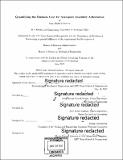Quantifying the business case for aerospace assembly automation
Author(s)
Caetano, Sean Michael
DownloadFull printable version (8.275Mb)
Other Contributors
Leaders for Global Operations Program.
Advisor
Kamal Youcef-Toumi and Scott Keating.
Terms of use
Metadata
Show full item recordAbstract
As aerospace Original Equipment Manufacturer's (OEM's) order backlogs soar to between six to ten years and growing, the community sees automation as vital to increasing throughput. Yet the community seems divided on the quantifiable financial benefits. While automation in aerospace assembly dates back to 1937, there is little substantive research on quantifying its business case. This thesis develops a financial model that predicts the benefit of introducing automation into an OEM's manual assembly line. The hypothesis of this project is that there is, in fact, a quantifiable benefit to implementing assembly automation into a current manual assembly process. Based on an initial automation capital investment, the financial model calculates the Net Present Value (NPV) of an aerospace automation project given various OEM production inputs such as: the annual production schedule, learning curve metrics, labor hour savings through automation, rework, health & safety metrics, and automation operating and downtime costs. A current program was used as a case study against the financial model. One significant finding is the effect production learning has on the labor hours saved from automation introduced in this thesis as the 'Efficiency Factor'. Based on the OEM's conservative production data and an initial automation investment of $12M the NPV for the project is about $16M for the firm order (600 ship sets) and about $27M for the entire program (2000 ship sets).
Description
Thesis: M.B.A., Massachusetts Institute of Technology, Sloan School of Management, in conjunction with the Leaders for Global Operations Program at MIT, 2017. Thesis: S.M., Massachusetts Institute of Technology, Department of Mechanical Engineering, in conjunction with the Leaders for Global Operations Program at MIT, 2017. Cataloged from PDF version of thesis. Includes bibliographical references (pages 87-88).
Date issued
2017Department
Leaders for Global Operations Program at MIT; Massachusetts Institute of Technology. Department of Mechanical Engineering; Sloan School of ManagementPublisher
Massachusetts Institute of Technology
Keywords
Sloan School of Management., Mechanical Engineering., Leaders for Global Operations Program.